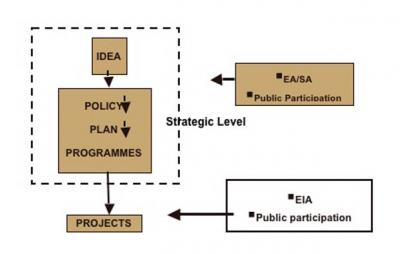Agenda 21, an outcome of the United Nations Conference on Environment and Development (UNCED) held in Rio de Janeiro, Brazil, in 1992, is an action plan of the United Nations related to sustainable development and good spatial planning, the English translation for ‘Aménagement du territoire’. Two imperatives of Agenda 21, of which Mauritius is signatory are that:
(1) There should be Environmental Assessment of all decision making pertaining to land use and
(2) Public Participation should be integrated in the development process.
Decision making in principle follows the 4 tiers approach – the 4 P’s: Policy, Plan, Programmes and Projects (Fig 1) and at each level, decisions are subject to Environmental Assessment and public participation.
In Mauritius it is common practice to have certain plans for major development subjected to Environmental Impact Assessment (EIA) at the project level. However it is questionable whether (1) the path for strategic decision making follows the 4 Ps procedure and (2) strategic decision about land use planning and development are subjected to Environmental Assessment and proper public participation. Local agenda 21 from chapter 28 of the Agenda 21 prescribes bringing the decision making in Land Use Planning from the central government level to local government levels which are closer to the public in their communal environment – hence a devolution strategy. This strategy which is in accordance with the principle of subsidiarity is a criterion which can guarantee both respect for democracy and the effective exercise of public power.
It is important to note here that the meaning of public participation is varied. According to the International Association for Public Participation (IAP2), five types of public participation approaches have been identified with an increasing level of public impact. These are (1) to inform (2) to consult (3) to involve (4) to collaborate and (5) to empower. The prescribed approach will depend on the context and specific circumstances.
Theoretical aspects of subsidiarity in planning have been approached from the point of view of a mandate ranging from coercive to cooperative government. Coercive is where there is an authoritarian approach from the Central government and a lack of commitment and non co-operation from the local government. The co-operative is committed and cooperates with the central government. Cooperation and coercion are seen as the two prototypical styles of intergovernmental policy implementation. These two styles differ substantially in the way that the higher and lower level governments relate in terms of the instruments used to ensure commitment and compliance with the policy, the capacity building component of policy implementation, and the discretion and local empowerment in selecting the means for achieving policy objectives.
The general current trends emphasise a movement in planning from the top-down technical or political dimensions where planning is imposed by expert advice based on scientific approaches or by politicians, to a more collaborative and communicative bottom-up Habermasian approach, where public participation is encouraged through public debates and discourses and where consensus and democracy are the key words – the communicative and collaborative planning. In such a process strategic discourses of different interests are ideally opened to include all interested parties, generating new planning discourses, allowing participants to gain knowledge of the positions and values of other participants, and creating capacity for collaborative action to change current conditions. The need for planning and planners to develop a capacity to ‘plan together’ with others, and acquire competence at navigating and appreciating the positions and claims of different groups and discourse communities (including other professions), is therefore presented as being of fundamental importance if the renewed promise of, and confidence in spatial planning is to be fully realised.
Aménagement du Territoire – Precautionary Approach
- Publicité -
EN CONTINU ↻


